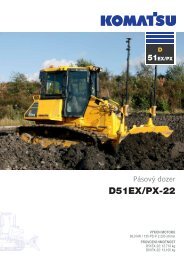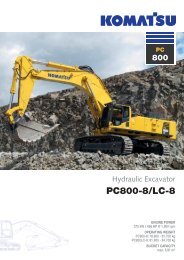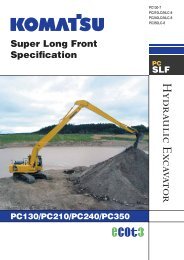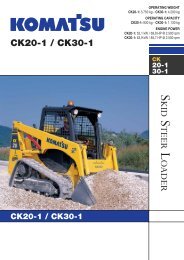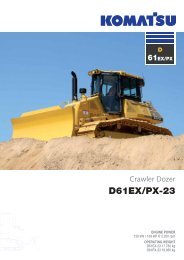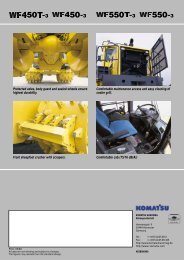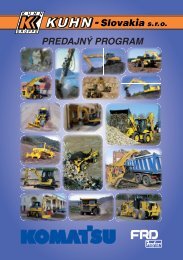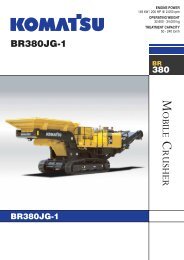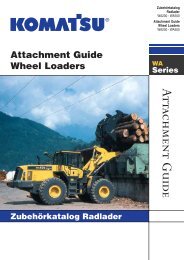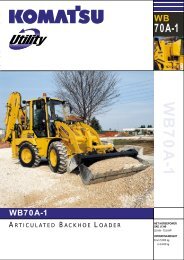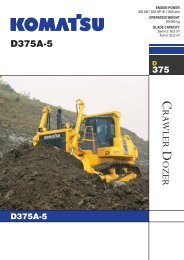Views 2012 No.1 - Komatsu America Corp.
Views 2012 No.1 - Komatsu America Corp.
Views 2012 No.1 - Komatsu America Corp.
You also want an ePaper? Increase the reach of your titles
YUMPU automatically turns print PDFs into web optimized ePapers that Google loves.
1<br />
KOMATSU HIGHLIGHTS<br />
2 Clearing Landmines and Restoring Communities<br />
around the World<br />
CUSTOMERS IN FOCUS<br />
4 Hard-Working WA600 Reaches 30,000-Work Hour<br />
Milestone with No Breakdowns<br />
6 Aiming for a New Eco-Friendly Quarry Industry<br />
by Introducing Hybrid Excavator and Recycling<br />
Quarry Sludge<br />
KOMATSU’S ENVIRONMENTAL INITIATIVES<br />
8 <strong>Komatsu</strong>’s Efforts to Reduce Environmental Impact<br />
CURRENT TOPICS<br />
14 Launch of the First Hybrid Excavator in Singapore<br />
15 <strong>Komatsu</strong> & Rio Tinto Enter into Agreement for<br />
150 Autonomous Truck Deployment into Pilbara Iron<br />
Ore Operations by 2015<br />
KOMATSU LINKS<br />
16 Check Out <strong>Komatsu</strong>’s “Kikki’s Workshop” Website!
<strong>Komatsu</strong>’s demining machine in Cambodia<br />
<strong>Komatsu</strong> commenced landmine removal,<br />
community reconstruction and other social<br />
contribution activities in Cambodia in 2008<br />
in conjunction with Japan Mine Action Service<br />
(JMAS), a non-profit organization registered in<br />
Japan. Similar activities were introduced in the<br />
West African nation of Angola in 2009. Such action<br />
continued in Cambodia and Angola in fiscal 2011.<br />
In this issue of <strong>Views</strong>, we introduce a two-year<br />
project in Cambodia that began in fiscal 2009 to<br />
turn a deserted minefield into a habitable community<br />
settlement, the first such initiative of its kind in<br />
that country.<br />
First, <strong>Komatsu</strong> loaned an anti-personnel demining<br />
machine, which was based on the D85 bulldozer,<br />
and other necessary construction equipment free of<br />
charge and supported JMAS with around a total of<br />
¥100 million to help carry out the project. In recognition<br />
of the significant value of the project, the<br />
Japanese government also contributed approximately<br />
¥30 million to JMAS.<br />
Clearing Landmines and<br />
Restoring Communities<br />
around the World<br />
By Atsushi Nagira, <strong>Komatsu</strong> Ltd.<br />
<strong>Komatsu</strong> equipment engaging in road improvement work<br />
2 <strong>Views</strong> <strong>2012</strong> <strong>No.1</strong>
Completed bridge<br />
Former minefield transformed into a habitable<br />
community settlement<br />
Each family was allocated with 1,000 m 2<br />
(10,764 ft 2 ) of land.<br />
Mr. Yoshinori Komamura, executive vice president<br />
of <strong>Komatsu</strong> Ltd., with Mr. Tun Chanareth, a<br />
member of the International Campaign to Ban<br />
Landmines which received the Nobel Peace Prize<br />
The project is being undertaken in a region<br />
straddling the Kilou and Chea Montrey villages in<br />
Battambang Province, the area in western Cambodia<br />
that has seen the most damage from landmines.<br />
Excluding the roads, the deserted minefield covers<br />
an area from the state highway to a 3-km (1.8-mi)<br />
point, where previously built floodgates have been<br />
broken and the whole area floods during the rainy<br />
season. Landmines also remain in farmland that<br />
stretches out along the roadside for roughly another<br />
3.5 km (2.2 mi) towards the hinterlands.<br />
The following five points summarize the steps<br />
taken during the two-year project.<br />
1) Landmines were removed from the 80 ha (198 ac)<br />
area of land along the roadside up to 3 km (1.8 mi)<br />
from the highway to ensure that the land is safe<br />
for 500 households.<br />
2) A bridge was built near the spot where the<br />
floodgates were constructed.<br />
3) Landmines were cleared to ensure that the 80 ha<br />
(198 ac) area alongside the road for 3.5 km (2.2 mi)<br />
towards the hinterlands is safe for farming.<br />
4) The total 6.5 km (4 mi) stretch of road was<br />
upgraded and 20 agricultural ponds for daily-use<br />
water were developed.<br />
5) Two <strong>Komatsu</strong> schools were constructed.<br />
The project was completed in spring 2011 and a<br />
commemoration ceremony was held in March 2011<br />
to celebrate the settlement of underprivileged residents<br />
in the immediate area. Representatives from<br />
both the Cambodian and Japanese governments as<br />
well as the chairperson of the board of JMAS and<br />
Mr. Yoshinori Komamura, executive vice president<br />
of <strong>Komatsu</strong> Ltd., attended the ceremony. All of<br />
them vowed to continue supporting landmine<br />
removal and reconstruction.<br />
<strong>Komatsu</strong> is committed to continue demining<br />
activities as a pillar of its social contribution efforts.<br />
<strong>Views</strong> <strong>2012</strong> <strong>No.1</strong> 3
Hard-Working WA600 Reaches<br />
30,000-Work Hour Milestone<br />
with No Breakdowns<br />
By Wafaa Ghali, <strong>Komatsu</strong> Australia Pty Ltd.<br />
Customers in Focus<br />
A Satisfied <strong>Komatsu</strong> Customer for<br />
More Than a Decade<br />
A <strong>Komatsu</strong> WA600 wheel loader purchased by<br />
Geraldton-based Central Earthmoving nearly five<br />
years ago has reached the 30,000-work hour mark<br />
by operating double shifts, 24 hours a day, seven<br />
days a week in a load-and-haul operation feeding a<br />
crusher, with no major repairs needed.<br />
As a result of the loader’s performance, Central<br />
Earthmoving has just purchased a new WA600 wheel<br />
loader, moving the older machine to a support role.<br />
The family-owned company, which has been in<br />
business since 1985, carries out a full range of civil<br />
construction works. Along with land development<br />
and road construction, other projects include mine<br />
servicing and infrastructure works throughout<br />
Western Australia. Operations span as far north as<br />
Halls Creek, south to Pinjarra and east to the<br />
Goldfields region around Kalgoorlie.<br />
According to Mr. Craig Patterson, managing<br />
director of Central Earthmoving, the company has<br />
owned and operated <strong>Komatsu</strong> equipment for over 10<br />
years. In addition to the two WA600 loaders, equipment<br />
includes a WA470 wheel loader; three PC300,<br />
Geraldton<br />
Golden Grove Mine<br />
Perth<br />
AUSTRALIA<br />
Sydney<br />
a PC200 and two PC270 hydraulic excavators;<br />
two GD555 motor graders; and three WA250PT<br />
tool carriers.<br />
The original WA600 has been the primary<br />
loading machine on a run-of-mine feed contract for<br />
the MMG Golden Grove underground base and precious<br />
metals mine, located approximately 450 km<br />
(280 mi) northeast of Perth. The mine consists of the<br />
Scuddles and Gossan Hill underground mines along<br />
with surface processing operations. “On that loader,<br />
we’ve made it to 30,000 hours without undertaking<br />
any significant repairs and then we had to upgrade the<br />
transmission and took the opportunity to rebuild the<br />
engine as well,” explained Mr. Patterson. “Over that<br />
4 <strong>Views</strong> <strong>2012</strong> <strong>No.1</strong>
period, all that stopped it was a couple of worn-out<br />
clutch packs. At the 30,000-hour mark, we took the<br />
opportunity to do a rebuild on the transmission, while<br />
for the engine, which was going fine, we decided to<br />
have it rebuilt by <strong>Komatsu</strong> at the same time.”<br />
The WA600, fitted with a 6-m 3 (7.8-yd 3 ) bucket,<br />
has been doing load-and-carry crusher feed over<br />
distances ranging from 60 to 200 m (66 to 219 yd).<br />
“It’s handling zinc and copper concentrate, which<br />
is very heavy, at about 3 tonnes/m 3 (5,057 lb/yd 3 ),”<br />
said Mr. Patterson. “It’s also very abrasive, resulting in<br />
us wearing out three buckets over the past five years.<br />
“MMG Golden Grove is a 24-hour operation, so<br />
really the only rest the loader got was for servicing<br />
and the occasional shutdown on the crusher or mill.<br />
Each day it works two 12-hour shifts, with the team<br />
guys on site doing two weeks on and one week off.<br />
That is an outstanding performance from that loader;<br />
it’s superior to any of the manufacturer’s estimations<br />
for the life of any of the components. We have<br />
exceeded all of those significantly.”<br />
<strong>Komatsu</strong> Quality and Operator Maintenance Key<br />
to Performance<br />
Throughout the loader’s life, Central Earthmoving<br />
has serviced it on site, bringing <strong>Komatsu</strong> field service<br />
personnel out for specific service and support<br />
needs. In addition to the quality and reliability built<br />
into the <strong>Komatsu</strong> wheel loader, a couple of other<br />
factors contributed to its performance.<br />
“I think our operators deserve recognition for<br />
how well they have looked after the machine,” said<br />
Mr. Patterson. “Our <strong>Komatsu</strong> sales representative<br />
and our people on site say that the way it has been<br />
operated and maintained, and the way our operators<br />
have looked after it, certainly helped to achieve this.<br />
Fitted with a 6-m 3 (7.8-yd 3 ) bucket, the WA600 loads and carries crusher feed.<br />
We have a core of three or four operators on the<br />
machine. Mr. Les Curley, our leading hand and also<br />
one of our mentors, has been key in setting the operating<br />
standards for how people treat the machine.”<br />
He added, “The other things we have done included<br />
putting an auto-greaser on the loader first up, which<br />
has given us exemplary life, plus we have always<br />
maintained <strong>Komatsu</strong> oil sampling and they have<br />
monitored it closely.”<br />
Given the performance of the original WA600<br />
over the past five years, Mr. Patterson noted that<br />
<strong>Komatsu</strong> as the choice of brand of the new wheel<br />
loader was pretty obvious. “Their support and<br />
service has been outstanding,” he said.<br />
“Our intention now is to keep the existing loader<br />
in a support role and to replace it with this new<br />
loader to continue on, as we have just gained a<br />
three-year extension on the contract at MMG<br />
Golden Grove.”<br />
Central Earthmoving operators (from left: Mr. Mark Jones, Mr. Les Curley and Mr. Gerald Olsen)<br />
<strong>Views</strong> <strong>2012</strong> <strong>No.1</strong> 5
Aiming for a New Eco-Friendly Quarry<br />
Industry by Introducing Hybrid Excavator<br />
and Recycling Quarry Sludge<br />
By Yuhei Iino, <strong>Komatsu</strong> Ltd.<br />
In business for more than 40 years, Yayoi Sekizai<br />
Co., Ltd. has been striving to enhance environmental<br />
friendliness not only by introducing a<br />
<strong>Komatsu</strong> hybrid excavator but also by effectively<br />
utilizing waste arising from quarry operations and<br />
recycling it into new resources. The roadbed<br />
material the company has developed from this<br />
waste has been certified as an exceptional recycled<br />
product. This initiative was aimed at making the<br />
next-generation quarry industry more environmentally<br />
friendly.<br />
Customers in Focus<br />
Saiki<br />
Tokyo<br />
JAPAN<br />
perspective, even if only slightly, we are more<br />
intent on reducing the environmental burden,”<br />
stated Mr. Hirohisa Kan, president of Yayoi<br />
Sekizai, as he explained the reason for introducing<br />
the machine. Although detailed data are currently<br />
being collected and analyzed, there is the potential<br />
to reduce fuel consumption by approximately 40%<br />
relative to conventional hydraulic excavators.<br />
“We were worried about possible trouble with the<br />
new machine when we introduced it, but <strong>Komatsu</strong>’s<br />
sound service system gave us peace of mind,”<br />
remarked Mr. Kan.<br />
At the Udoki quarry where the PC650 and PC450 hydraulic excavators are in operation, up to 600 m 3 (784 yd 3 )<br />
of crushed stone is produced every day for the construction of the Higashi Kyushu Expressway.<br />
Introduction of Hybrid Excavator to Rugged<br />
Quarries<br />
Headquartered in Saiki City, Oita Prefecture, Yayoi<br />
Sekizai was established in 1970. It currently has two<br />
quarries: one in Udoki and the other in Sakanoura,<br />
boasting monthly crushed stone production capacity<br />
of 30,000 m 3 (39,237 yd 3 ).<br />
The quarries employ machines on a full-time<br />
basis every day. For instance, the PC650 hydraulic<br />
excavator has been in use for 21,000 hours since its<br />
introduction and the PC350 for 32,000 hours.<br />
Despite the tough working conditions, no major<br />
trouble has arisen along the way, demonstrating how<br />
well the machines have been maintained.<br />
In January 2011, the HB205 hybrid excavator<br />
was introduced at one site. “We currently consume<br />
40,000r (10,568 gal) of fuel per month. Although<br />
we are happy to reduce fuel costs from a managerial<br />
Certified Recycled Material Developed through<br />
Joint Collaboration<br />
Although sand and stones are necessary to produce<br />
concrete, beach sand cannot be employed, and as<br />
such, sand is now being produced by grinding down<br />
rocks taken from mountain areas. However, the<br />
resulting sludge still has to be reinserted into the<br />
mountain area that the rocks were taken from.<br />
Ready-mixed concrete factories face the same<br />
dilemma in terms of disposing of waste generated in<br />
Mr. Hirohisa Kan,<br />
president of<br />
Yayoi Sekizai Co., Ltd.<br />
6 <strong>Views</strong> <strong>2012</strong> <strong>No.1</strong>
The Need to Develop Eco-Friendly Construction<br />
Materials<br />
“RETERRA” mobile soil recycler in use at the Udoki quarry<br />
production. Aiming to effectively utilize this waste,<br />
government-industry-academia collaboration led by<br />
Yayoi Sekizai in cooperation with Oita Prefecture<br />
and Nippon Bunri University resulted in “recycled<br />
crusher run RRC-40.”<br />
The RRC-40 roadbed material is made from a<br />
mixture of concrete and other lime-based waste.<br />
During development, it was extremely difficult<br />
to blend these elements evenly, according to<br />
Mr. Kan. That all changed with the launch of the<br />
<strong>Komatsu</strong> “RETERRA” mobile soil recycler, which<br />
already boasted an excellent track record. This<br />
machine enables the blend ratio to be changed via<br />
computer control, which results in the successful<br />
production of high-quality recycled roadbed<br />
material. “We had no choice but to dispose of<br />
by-products generated during production as waste,”<br />
stated Mr. Kan as he recalled the time of development.<br />
“If we can reuse this waste and make it into<br />
a viable resource, we can help reduce the environmental<br />
burden.”<br />
Yayoi Sekizai, which delivers crushed stone<br />
primarily to local engineering businesses, has seen<br />
shipment volume almost halved compared with 10<br />
years ago due to a decline in public works construction.<br />
“Although production of crushed stone has<br />
increased recently with the start of construction<br />
for the Higashi Kyushu Expressway, orders for<br />
construction work have decreased in general,”<br />
commented Mr. Kan. “News reports relayed how<br />
the tsunami that followed the Great East Japan<br />
Earthquake destroyed Japan’s best breakwaters.<br />
However, some people were of the opinion that<br />
these breakwaters in fact delayed the arrival of the<br />
tsunami. Since Japan is surrounded by sea, it is<br />
essential that we have sturdy shore protection. In<br />
line with the view that concrete can protect people,<br />
we cannot underestimate the importance of public<br />
works projects.”<br />
Touching on the importance of Yayoi Sekizai’s<br />
corporate stance to develop new products by taking<br />
consideration of the environment into account, he<br />
added: “Although concrete will continue to be used<br />
as a building material, there is little doubt that it will<br />
become increasingly difficult to employ virgin<br />
material in civil engineering going forward. It is<br />
therefore essential to develop new construction<br />
materials from the perspectives of recycling and the<br />
environment to replace conventional materials.”<br />
In operation at the Sakanoura quarry, the HB205<br />
hybrid excavator is expected to reduce fuel<br />
consumption by approximately 40% relative to<br />
conventional hydraulic excavators.<br />
<strong>Views</strong> <strong>2012</strong> <strong>No.1</strong> 7
<strong>Komatsu</strong>’s Environmental Initiatives<br />
<strong>Komatsu</strong>’s Efforts to Reduce<br />
Environmental Impact<br />
KOMTRAX for Accurate Servicing and<br />
Reduced Environmental Impact<br />
KOMTRAX adds a GPS antenna and wireless<br />
communications technology to <strong>Komatsu</strong> construction<br />
equipment operating anywhere in the world.<br />
KOMTRAX is a remote management system that<br />
monitors the “health” and operational status of vehicles.<br />
KOMTRAX Plus, designed for use in mining equipment, can<br />
collect detailed status information on vehicles and use the<br />
data to control mining equipment operating under severe<br />
conditions. Using these ICT-based systems, <strong>Komatsu</strong> is<br />
improving the quality of its service to customers and<br />
reducing environmental impact.<br />
Supporting Our Customers with KOMTRAX<br />
Just as automobiles require regular replacement of<br />
engine oil and oil filters, construction equipment<br />
requires periodic maintenance. However, because<br />
construction equipment operates under much<br />
harsher conditions, maintenance work must be<br />
extremely efficient to ensure that equipment<br />
productivity is stable. Ideally, the frequency of<br />
inspections and parts replacement should be based<br />
on the respective number of operating hours logged<br />
on the equipment.<br />
KOMTRAX offers real-time access to<br />
equipment information, such as the number of<br />
operating hours, the last date a part was replaced<br />
and the next replacement period. This lets service<br />
personnel plan timely inspections and parts<br />
replacement and allows preventive maintenance<br />
measures to be implemented. The result is a steady<br />
reduction in maintenance-related waste for the<br />
Machine Management System (KOMTRAX)<br />
Communication Satellite / Mobile Phone<br />
GPS<br />
KOMTRAX Terminal<br />
Machine Data Server<br />
GPS antenna<br />
Communication antenna<br />
KOMTRAX Controller<br />
Modem<br />
Web Application Server<br />
Internet<br />
Pump controller<br />
Engine controller<br />
Multi-monitor<br />
In-vehicle<br />
network<br />
Machine<br />
Customer / Distributor / <strong>Komatsu</strong><br />
8 <strong>Views</strong> <strong>2012</strong> <strong>No.1</strong>
customer, as well as reduced maintenance costs<br />
associated with such waste.<br />
KOMTRAX information can also be used to<br />
devise more efficient ways of operating equipment<br />
based on worksite characteristics. Selecting more<br />
appropriate models and using equipment more<br />
efficiently leads to lower fuel consumption and<br />
less environmental impact.<br />
KOMTRAX Plus for Mining Equipment Used in<br />
Harsh Operating Environments<br />
Heavy-duty mining equipment operates at sites<br />
where natural resources that support our daily<br />
lives, such as coal and iron ore, are extracted.<br />
Mining equipment, once it is at the mining site,<br />
will remain there in full operation, day and night.<br />
Moreover, this equipment is expected to provide<br />
stable operation at all times.<br />
Minimizing idle time due to breakdowns<br />
requires planned maintenance and parts<br />
replacement.<br />
KOMTRAX Plus helps meet the challenges<br />
posed by harsh operating conditions.<br />
KOMTRAX Plus collects data from numerous<br />
sensors installed on mining equipment and provides<br />
real-time information (equipment health and<br />
operating information) that is used in the operation<br />
of this large-size equipment. The information is<br />
transmitted via satellite and consolidated in the<br />
EQP Care equipment allocation system.<br />
Using the EQP Care system, customers,<br />
distributors, local subsidiaries and <strong>Komatsu</strong><br />
can access a variety of information about<br />
equipment via the Internet.<br />
In addition to making KOMTRAX Plus data<br />
available, EQP Care also consolidates various service<br />
and support information for each vehicle, then<br />
makes comprehensive use of this data to propose<br />
accurate preventive maintenance measures to the<br />
customer. These measures are designed to improve<br />
operation rates and optimize overhaul times to<br />
reduce repair costs.<br />
In addition, the system can analyze the way<br />
vehicles are used and, based on this data, suggest<br />
more efficient operating methods, thus reducing<br />
environmental impact by making operation more<br />
fuel-efficient.<br />
Customers<br />
Monitoring of equipment<br />
health and<br />
operational<br />
status<br />
Equipment<br />
operating<br />
information<br />
KOMTRAX Plus and EQP Care<br />
Distribution<br />
over the<br />
Internet<br />
Accurate<br />
servicing<br />
EQP Care<br />
Information<br />
storage<br />
and distribution<br />
<strong>Komatsu</strong><br />
Product planning<br />
and development<br />
Production planning<br />
Parts repair planning<br />
Distributor<br />
Maintenance based<br />
on R&M plan<br />
Parts procurement<br />
and planned maintenance<br />
<strong>Views</strong> <strong>2012</strong> <strong>No.1</strong> 9
<strong>Komatsu</strong>’s Environmental Initiatives<br />
<strong>Komatsu</strong>’s Efforts to Reduce Environmental Impact<br />
Voices<br />
KOMTRAX Plus Helps<br />
Customers Reduce their<br />
Fuel Consumption<br />
Devi Ari Suryadi<br />
PT <strong>Komatsu</strong> Marketing and<br />
Support Indonesia (KMSI)<br />
Mohamad Sholahudin<br />
PT <strong>Komatsu</strong> Marketing and<br />
Support Indonesia (KMSI)<br />
Indonesia is rich in mineral resources and<br />
plays an important role in supplying the<br />
world with coal. A large number of mining<br />
machines manufactured by <strong>Komatsu</strong> are<br />
in operation in Indonesian mines, and the<br />
role KMSI plays in these developments is<br />
growing day by day.<br />
Although Indonesia is a coal-producing<br />
country, the cost of fuel for running mining<br />
equipment has roughly quadrupled over the<br />
past five years. This increase in fuel prices<br />
has caused the costs of operating a mining<br />
business to swell by nearly 20%, eating into<br />
customer profits. Dump trucks, in particular,<br />
use a large amount of fuel as they drive up<br />
the slopes of a mine, making the high fuel<br />
cost for dump trucks one of our customers’<br />
biggest headaches.<br />
Even PT Pamapersada Nusantara<br />
(PAMA), our largest customer in Indonesia,<br />
has asked us to help reduce the fuel cost for<br />
dump trucks.<br />
To meet this request, we decided to make<br />
extensive use of KOMTRAX Plus. After<br />
analyzing the data of a dump truck with a<br />
payload of 90 tonnes (101 U.S. tons),<br />
<strong>Komatsu</strong> worked together with its distributors,<br />
KMSI and PAMA to successfully<br />
reduce fuel consumption. The activities that<br />
led to this success are described as follows.<br />
In line with The KOMATSU Way and the<br />
importance it assigns to the work site, we<br />
started the process with a field study. We<br />
investigated the course taken by dump trucks<br />
at the work site and conducted detailed analyses<br />
of the driving methods of operators.<br />
After careful analysis of the collected data,<br />
we found that we could decrease fuel<br />
consumption by using “economy mode” in<br />
combination with certain course patterns.<br />
After the field study, we began training<br />
activities. Distributors trained operators<br />
in driving methods that decreased fuel<br />
consumption. PAMA revised its standard<br />
operating procedures for mining operations<br />
to emphasize to their operators the need for<br />
energy conservation.<br />
A strength of KOMTRAX Plus is the<br />
capability it provides for visualizing the<br />
results of these efforts. A comparison of<br />
fuel consumption before and after the countermeasures<br />
clearly shows their effect.<br />
PAMA acknowledged that the measures had<br />
brought about a reduction in fuel consumption<br />
in this particular case, but also<br />
expressed the hope that <strong>Komatsu</strong> will be<br />
able to generally improve the fuel efficiency<br />
of its equipment.<br />
Our goal is to continue approaching our<br />
customers with various proposals for<br />
improvements using KOMTRAX Plus,<br />
including measures to reduce fuel consumption,<br />
and thereby help to boost customer<br />
satisfaction.<br />
Discussion with PAMA operators about fuel-saving<br />
operation based on KOMTRAX Plus data<br />
10 <strong>Views</strong> <strong>2012</strong> <strong>No.1</strong>
The Story behind the Development of<br />
Tier 4 Compliant Vehicles/Engines<br />
Since 1996, the exhaust emission regulations applicable to construction equipment in Japan,<br />
the United States and Europe have become increasingly stringent every five years, and in<br />
2011, entered a stage in which Tier 4 (Stage IIIB in Europe) regulations came into force.<br />
This required advanced technology to make exhaust gas “cleaner” and improve fuel<br />
efficiency. In this issue of <strong>Views</strong>, we asked members of the Research and Development<br />
divisions who helped to overcome these challenges to tell us about their passionate<br />
involvement in their work.<br />
Vehicles with Tier 4 Compliant Engines<br />
The Road to Tier 4 Compliant Hydraulic<br />
Excavators and Improved Fuel Efficiency<br />
(Reduction of CO2)<br />
Seiichi Fuchida, Group Manager<br />
Hydraulic Excavator Development Group, Construction Equipment Development Center 1,<br />
Development Division<br />
The following are the main issues faced in the<br />
development of Tier 4 compliant vehicles:<br />
(1) Improvement in engine exhaust heat rejection<br />
(2) Space required to mount exhaust gas treatment<br />
equipment<br />
(3) Creation of control logic for exhaust gas treatment<br />
equipment<br />
(4) Improvement in fuel efficiency<br />
In earlier research, <strong>Komatsu</strong> confirmed the<br />
performance of Tier 4 test vehicles after benchmark<br />
tests and tests of Tier 3 vehicles. Tests were<br />
conducted under different climatic conditions, such<br />
as at high altitudes and in extreme cold, and<br />
assuming various loads. Tier 4 compliance and<br />
improved fuel efficiency (10% lower than conventional<br />
equipment) were confirmed in the previous<br />
research. A method for evaluating fuel efficiency<br />
was also established so that our customers could<br />
actually see that they are saving fuel.<br />
We encountered considerable difficulties in our<br />
development trying to satisfy the requirement for<br />
improved fuel efficiency. At the same time, we<br />
faced problems that had not been experienced,<br />
such as freezing of the intake circuit and soot (PM)<br />
formation due to incomplete combustion by the<br />
Tier 4 compliant <strong>Komatsu</strong> diesel particulate filter<br />
(KDPF). However, regardless of how<br />
imposing the problems were, we overcame them<br />
by mustering all our resources.<br />
I think this was due, firstly, to <strong>Komatsu</strong>’s<br />
technical capabilities and, secondly, to those who<br />
uphold the company’s corporate tradition. Our<br />
quest for environmentally friendly products will<br />
never stop.<br />
Keeping this in mind, we will continue to focus<br />
our efforts on development.<br />
PC240LC hydraulic excavator<br />
<strong>Views</strong> <strong>2012</strong> <strong>No.1</strong> 11
<strong>Komatsu</strong>’s Environmental Initiatives<br />
<strong>Komatsu</strong>’s Efforts to Reduce Environmental Impact<br />
Development of D65-17 Bulldozer<br />
(Tier 4 Compliant)<br />
Kazushi Nakata, Team Leader<br />
Small Equipment Development Group, Construction Equipment Development Center 1,<br />
Development Division<br />
The D65-17 bulldozer inherited the low fuel<br />
consumption (5% lower than conventional equipment)<br />
achieved with the D65-16, and has been<br />
further developed to incorporate ICT (Information<br />
and Communication Technology) and to feature<br />
higher environmental compatibility and safety.<br />
We modified the engine in various ways, for<br />
example, by adding exhaust gas aftertreatment<br />
equipment and a variable geometry turbocharger.<br />
We tried not to compromise the vehicle’s performance,<br />
including its acceleration, responsiveness<br />
and fuel efficiency. To confirm that the exhaust<br />
gas aftertreatment equipment works normally<br />
under different conditions, we conducted various<br />
environmental assessments, including high<br />
altitude tests in Nagano Prefecture and low<br />
temperature tests in Rikubetsucho, Hokkaido.<br />
This was followed by renewed testing of the<br />
control system and included hardware fixes.<br />
Although our development schedule was tight,<br />
we were able to start mass production with minimum<br />
delay, thanks to the cooperation of all the<br />
development centers and manufacturing staff.<br />
D65-17 bulldozer<br />
The Road to Improved Fuel Efficiency<br />
(Reduction of CO2) in Dump Trucks<br />
Hitoshi Nakanishi, Team Leader<br />
Dump Truck Development Group,<br />
Construction Equipment Development Center 2, Development Division<br />
With the HM300-3 articulated dump truck, we<br />
developed a product that has exceptionally low<br />
fuel consumption (8% less than conventional<br />
equipment) and is able to handle the same work<br />
load as a conventional dump truck. On top of this,<br />
the product features lower noise and environmentally<br />
friendly operation.<br />
To achieve this, we needed to use a variable<br />
piston pump to efficiently control the engine rpm<br />
and torque, as well as the hydraulic pressure. It<br />
took repeated tuning sessions to achieve maximum<br />
performance for the dump truck and to<br />
complete its development.<br />
On-screen eco guidance as a visual aid helps<br />
improve fuel efficiency.<br />
HM300-3 articulated dump truck<br />
12 <strong>Views</strong> <strong>2012</strong> <strong>No.1</strong>
Tier 4 Compliant Engines<br />
Developing Engines Compliant with 2011<br />
Emission Standards<br />
Yoshimi Tamura, Senior Manager<br />
Planning Office, Engine Development Center, Development Division<br />
Compared with a Tier 3 compliant engine, a Tier 4<br />
compliant engine is required to reduce PM emissions<br />
to one-tenth of the previous level, so the Tier<br />
4 emission standard is a very stringent requirement<br />
that cannot be met simply by extending the<br />
technology used for the transition from Tier 2 to<br />
Tier 3. Technology used in existing on-road trucks<br />
cannot be applied to construction equipment, so<br />
we devoted considerable time and effort to<br />
develop an aftertreatment device and a variable<br />
geometry turbocharger to reduce PM emissions.<br />
Leveraging <strong>Komatsu</strong>’s in-house vehicle and<br />
engine development and production capabilities,<br />
we laid out a detailed set of check items and<br />
succeeded in developing a product that was<br />
differentiated from our competitors’ products.<br />
Variable Geometry Turbocharger<br />
Intake<br />
Variable geometry nozzle<br />
Exhaust<br />
Challenge to Develop Tier 4 Compliant <strong>Komatsu</strong><br />
Diesel Particulate Filter (KDPF)<br />
Shinichiro Inoue, Team Leader<br />
Component Technology Unit 2,<br />
Construction Equipment Innovation Center 3, Research Division<br />
Having had experience in marketing products<br />
equipped with the KDPF since before the time<br />
of the Tier 3 emission standards, <strong>Komatsu</strong> was<br />
initially under the impression that evolving this<br />
technology to meet the Tier 4 requirements would<br />
be easy. But working on Tier 4, we soon realized<br />
that conditions had changed significantly in comparison<br />
with Tier 3 because of the drastically<br />
lower exhaust gas temperature. The problem we<br />
identified was that the PM collected in the KDPF<br />
did not combust naturally during operation,<br />
but instead continued to accumulate. To solve<br />
this problem we needed to develop a forced<br />
regeneration system that would combust the PM<br />
accumulated in the KDPF whenever it reaches a<br />
certain level. Due to these unexpected problems we<br />
had to work day and night to meet the deadline.<br />
<strong>Komatsu</strong> Diesel Particulate Filter (KDPF)<br />
Oxidation catalyst<br />
Soot filter<br />
<strong>Views</strong> <strong>2012</strong> <strong>No.1</strong> 13
CURRENT<br />
TOPICS<br />
Launch of the First Hybrid Excavator<br />
in Singapore<br />
By Nandha Kumar, <strong>Komatsu</strong> Asia & Pacific Pte Ltd<br />
On December 9, 2011, <strong>Komatsu</strong> Ltd. and UMW<br />
Equipment & Engineering Pte Ltd (UMW),<br />
the exclusive <strong>Komatsu</strong> distributor in<br />
Singapore, launched their newest product, the<br />
HB205 hybrid excavator. The two-part launching<br />
ceremony included a sumptuous lunch for customers<br />
indoors followed by a display and demonstration of<br />
the HB205 outdoors. The event at the compound of<br />
<strong>Komatsu</strong> Asia & Pacific Pte Ltd (KAP) was<br />
attended by more than 120 construction equipment<br />
owners from Singapore. The chairwoman of the<br />
Singapore Environment Council, Ms. Isabella Loh,<br />
was the guest of honor.<br />
This was the first time in Singapore that a<br />
<strong>Komatsu</strong> machine launch of such a large scale was<br />
carried out at KAP’s premises and the turnout for<br />
the event was indicative of its success. A delicious<br />
lunch buffet in honor of customers was followed by<br />
presentations by the hosts, Mr. Masaaki Kanayama,<br />
KAP’s president, and Mr. Chew Chee Loon,<br />
UMW’s executive director. Ms. Loh then took to the<br />
stage to congratulate both <strong>Komatsu</strong> and UMW for<br />
the successful launch and express appreciation for<br />
<strong>Komatsu</strong>’s efforts to help save the planet. As a sign<br />
of <strong>Komatsu</strong>’s and UMW’s commitment to the environment,<br />
a cheque from the two companies was<br />
jointly presented to the Singapore Environment<br />
Council. In appreciation to customers who ordered<br />
the machines prior to the launch, a key presentation<br />
A key presentation ceremony for a customer who ordered the HB205 prior to the launch<br />
ceremony was held as part of the indoor ceremony.<br />
The key parts of the outdoor segment were the<br />
static machine and parts components display, and<br />
the demonstration of the HB205. The hybrid show<br />
then started with a professional machine demonstrator<br />
from UMW, in which customers were impressed<br />
by the equipment’s capabilities and fuel-saving<br />
technology. The guests were then invited to try<br />
operating the hybrid with the guidance of <strong>Komatsu</strong><br />
staff. Many eager customers took part in the test<br />
operation of the HB205 before the launching<br />
ceremony came to a close.<br />
Singapore has long been at the forefront of<br />
environmental protection in this region. Now, the<br />
<strong>Komatsu</strong> HB205 is ready to work hard to support<br />
this cause.<br />
Ms. Isabella Loh, chairwoman of the Singapore<br />
Environment Council, congratulating the<br />
successful launch of the HB205<br />
Outside display of the static machine<br />
14 <strong>Views</strong> <strong>2012</strong> <strong>No.1</strong>
CURRENT<br />
TOPICS<br />
<strong>Komatsu</strong> & Rio Tinto Enter into Agreement<br />
for 150 Autonomous Truck Deployment<br />
into Pilbara Iron Ore Operations by 2015<br />
<strong>Komatsu</strong> Ltd. and Rio Tinto have signed a<br />
Memorandum of Understanding (MOU) to<br />
take the next step in large-scale implementation<br />
of the <strong>Komatsu</strong> Autonomous Haulage System<br />
(AHS). The two companies committed to deploy a<br />
minimum of 150 <strong>Komatsu</strong> AHS trucks for Rio Tinto<br />
Pilbara Iron Ore operations in Western Australia<br />
by the end of 2015, with delivery of equipment<br />
commencing in <strong>2012</strong>.<br />
“We are extremely excited to sign the MOU with<br />
Rio Tinto to expand the fleet to at least 150 <strong>Komatsu</strong><br />
AHS trucks in their Western Australian Pilbara operations<br />
by the end of 2015,” said Mr. Kunio Noji,<br />
<strong>Komatsu</strong> president and CEO. “<strong>Komatsu</strong> and Rio<br />
Tinto are global partners and have developed a<br />
strong alliance throughout the years. We are confident<br />
that our leading-edge AHS technology will<br />
accelerate Rio Tinto’s Mine of the Future<br />
objectives through improving safety and mine<br />
operations.”<br />
Mr. Tom Albanese, Rio Tinto chief executive,<br />
commented, “This announcement further reinforces<br />
our longstanding alliance with <strong>Komatsu</strong>. We have<br />
been partnering with <strong>Komatsu</strong>, using their advanced<br />
truck technology at our mines, for almost 20 years.<br />
“Autonomous haulage is an important component<br />
in our Mine of the Future program. These<br />
new 150 autonomous trucks will work with our<br />
pioneering operations center that integrates and<br />
manages the logistics of 14 mines, three ports and<br />
two railways. These technologies are revolutionizing<br />
the way large-scale mining is done, creating<br />
attractive high-tech jobs, and helping us improve<br />
safety and environmental performance, and reduce<br />
carbon emissions.”<br />
Rio Tinto has been testing the <strong>Komatsu</strong> AHS,<br />
the world’s first commercial autonomous mining<br />
haulage system, at the West Angelas mine in the<br />
Pilbara region since December 2008. During the<br />
trials, the AHS technology demonstrated clear value<br />
to the business especially in the areas of health,<br />
safety and productivity.<br />
The MOU was signed in Tokyo, Japan, in 2011<br />
by Mr. Noji and Mr. Albanese in the presence of<br />
Mr. Greg Lilleyman, Rio Tinto Iron Ore president<br />
Pilbara Operations, and senior executives from<br />
both companies.<br />
Mr. Tom Albanese (right), chief executive of Rio Tinto, and Mr. Kunio Noji, president<br />
and CEO of <strong>Komatsu</strong> Ltd., at the MOU signing ceremony<br />
<strong>Views</strong> <strong>2012</strong> <strong>No.1</strong> 15
Check Out <strong>Komatsu</strong>’s<br />
“Kikki’s Workshop” Website!<br />
In order for people to feel familiar with construction<br />
equipment, <strong>Komatsu</strong> has set up a website<br />
both grown-ups and children can enjoy. On the<br />
“Kikki’s Workshop” website, two characters—<br />
Kenken and Kikki—along with their friends provide<br />
an easy-to-understand introduction to construction<br />
equipment. Available for 15 years since 1997, the<br />
interactive website offers sections that allow users to<br />
enter a coloring picture contest, ask questions<br />
regarding construction equipment and learn about<br />
other interesting topics.<br />
The following are a few examples of the content<br />
available on the website.<br />
The Great Picture Book of Construction<br />
Equipment<br />
Photos and videos of various construction<br />
equipment<br />
Everything about Construction Equipment<br />
Easy-to-understand explanation regarding the<br />
mechanisms of construction equipment<br />
Q&A Let’s ask Kikki!<br />
Answers to all you want to know about<br />
construction equipment<br />
The Coloring Picture Grand Prix<br />
Annual picture-coloring event in which <strong>Komatsu</strong><br />
receives a lot of wonderful pictures from around<br />
the world. The next application period is<br />
scheduled from June <strong>2012</strong> to January 2013.<br />
Download Corner<br />
Wallpapers, calendars, screen savers and other<br />
fun items are available in this section.<br />
http://www.kenkenkikki.jp/e_index2.html<br />
<strong>Views</strong> is a PR magazine published by <strong>Komatsu</strong> Ltd.<br />
Construction & Mining Equipment Marketing Division<br />
2-3-6, Akasaka, Minato-ku, Tokyo 107-8414, Japan<br />
http://www.komatsu.com<br />
E-mail: views@komatsu.co.jp<br />
This magazine is printed on recycled paper and is recyclable.<br />
<strong>2012</strong><br />
<strong>2012</strong><br />
No. No.<br />
1<br />
• Product photos in this magazine may show optional equipment.<br />
• Product specifications are subject to change without notice.<br />
• Available models may vary by region or country.<br />
• Models shown in this magazine may be positioned for photographic purposes, with<br />
the bucket up. For safety reasons, please leave the equipment in a secure position.<br />
• All rights reserved. No part of this magazine may be reproduced without the prior<br />
written permission of <strong>Komatsu</strong> Ltd.<br />
• The comments expressed in this magazine are those of the contributors, and are not<br />
necessarily endorsed by <strong>Komatsu</strong> Ltd.<br />
We welcome any comments from <strong>Views</strong> readers via email:<br />
views@komatsu.co.jp<br />
Form No. AEN00003-23



